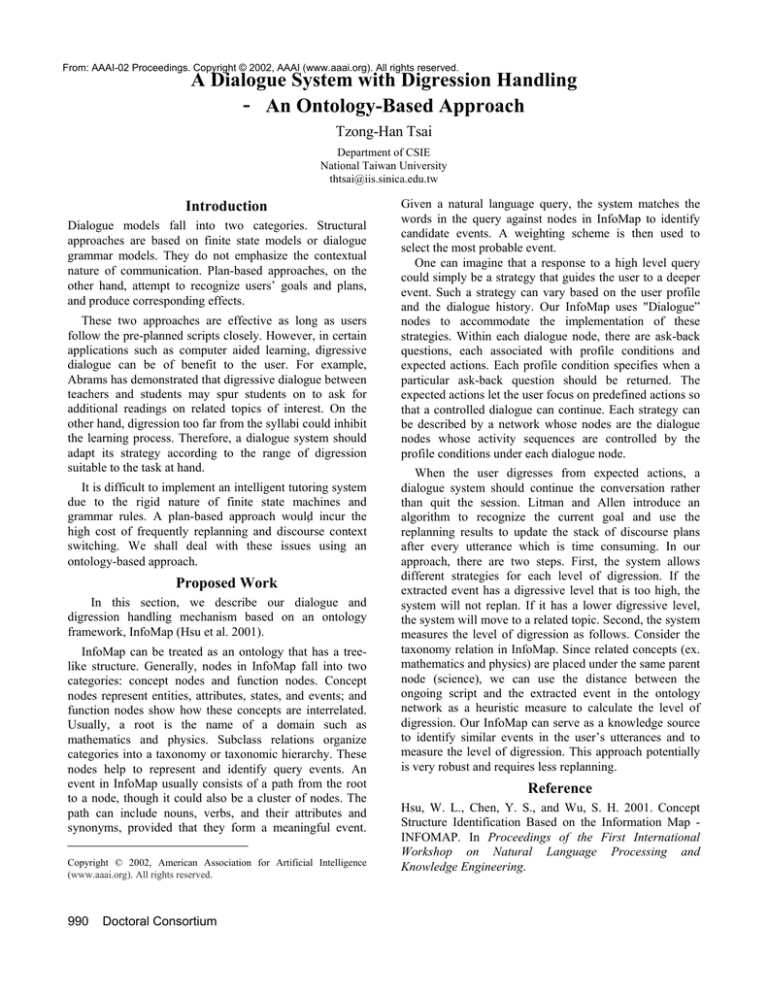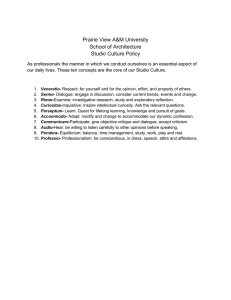
From: AAAI-02 Proceedings. Copyright © 2002, AAAI (www.aaai.org). All rights reserved.
A Dialogue System with Digression Handling
- An Ontology-Based Approach
Tzong-Han Tsai
Department of CSIE
National Taiwan University
thtsai@iis.sinica.edu.tw
Introduction
Dialogue models fall into two categories. Structural
approaches are based on finite state models or dialogue
grammar models. They do not emphasize the contextual
nature of communication. Plan-based approaches, on the
other hand, attempt to recognize users’ goals and plans,
and produce corresponding effects.
These two approaches are effective as long as users
follow the pre-planned scripts closely. However, in certain
applications such as computer aided learning, digressive
dialogue can be of benefit to the user. For example,
Abrams has demonstrated that digressive dialogue between
teachers and students may spur students on to ask for
additional readings on related topics of interest. On the
other hand, digression too far from the syllabi could inhibit
the learning process. Therefore, a dialogue system should
adapt its strategy according to the range of digression
suitable to the task at hand.
It is difficult to implement an intelligent tutoring system
due to the rigid nature of finite state machines and
grammar rules. A plan-based approach would incur the
high cost of frequently replanning and discourse context
switching. We shall deal with these issues using an
ontology-based approach.
Proposed Work
In this section, we describe our dialogue and
digression handling mechanism based on an ontology
framework, InfoMap (Hsu et al. 2001).
InfoMap can be treated as an ontology that has a treelike structure. Generally, nodes in InfoMap fall into two
categories: concept nodes and function nodes. Concept
nodes represent entities, attributes, states, and events; and
function nodes show how these concepts are interrelated.
Usually, a root is the name of a domain such as
mathematics and physics. Subclass relations organize
categories into a taxonomy or taxonomic hierarchy. These
nodes help to represent and identify query events. An
event in InfoMap usually consists of a path from the root
to a node, though it could also be a cluster of nodes. The
path can include nouns, verbs, and their attributes and
synonyms, provided that they form a meaningful event.
Copyright © 2002, American Association for Artificial Intelligence
(www.aaai.org). All rights reserved.
990
Doctoral Consortium
Given a natural language query, the system matches the
words in the query against nodes in InfoMap to identify
candidate events. A weighting scheme is then used to
select the most probable event.
One can imagine that a response to a high level query
could simply be a strategy that guides the user to a deeper
event. Such a strategy can vary based on the user profile
and the dialogue history. Our InfoMap uses "Dialogue”
nodes to accommodate the implementation of these
strategies. Within each dialogue node, there are ask-back
questions, each associated with profile conditions and
expected actions. Each profile condition specifies when a
particular ask-back question should be returned. The
expected actions let the user focus on predefined actions so
that a controlled dialogue can continue. Each strategy can
be described by a network whose nodes are the dialogue
nodes whose activity sequences are controlled by the
profile conditions under each dialogue node.
When the user digresses from expected actions, a
dialogue system should continue the conversation rather
than quit the session. Litman and Allen introduce an
algorithm to recognize the current goal and use the
replanning results to update the stack of discourse plans
after every utterance which is time consuming. In our
approach, there are two steps. First, the system allows
different strategies for each level of digression. If the
extracted event has a digressive level that is too high, the
system will not replan. If it has a lower digressive level,
the system will move to a related topic. Second, the system
measures the level of digression as follows. Consider the
taxonomy relation in InfoMap. Since related concepts (ex.
mathematics and physics) are placed under the same parent
node (science), we can use the distance between the
ongoing script and the extracted event in the ontology
network as a heuristic measure to calculate the level of
digression. Our InfoMap can serve as a knowledge source
to identify similar events in the user’s utterances and to
measure the level of digression. This approach potentially
is very robust and requires less replanning.
Reference
Hsu, W. L., Chen, Y. S., and Wu, S. H. 2001. Concept
Structure Identification Based on the Information Map INFOMAP. In Proceedings of the First International
Workshop on Natural Language Processing and
Knowledge Engineering.




